|
|
|
Sort Order |
|
|
|
Items / Page
|
|
|
|
|
|
|
| Srl | Item |
| 1 |
ID:
104007
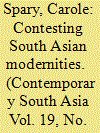

|
|
|
|
|
| Publication |
2011.
|
| Summary/Abstract |
This Editorial introduces the papers in this special conference issue of Contemporary South Asia, placing them in the context of the 24th British Association for South Asian Studies (BASAS) annual conference, held at the University of Warwick in March 2010. The conference theme was 'Landscapes of the imagination', and the papers in this Special Issue reflect a range of approaches to this theme, in terms of methodology, topic and regional spread. Despite their diversity, however, the papers do reflect a common concern to contest a singular, unproblematic and unified experience of South Asian modernity.
|
|
|
|
|
|
|
|
|
|
|
|
|
|
|
|
| 2 |
ID:
104010
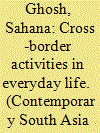

|
|
|
|
|
| Publication |
2011.
|
| Summary/Abstract |
This paper will address the multiple forms and layers of porosity that give borderlands, such as the Bengal borderland, their distinctive nature as zones of contestation. Cross-border interactions continue to be an integral feature of everyday life in the Bengal borderland despite increasing militarisation and regulation by the Indian government in the last decade. Criminalization of local cross-border flows has driven them underground - while organized cross-border crimes (smuggling and trafficking) enjoy considerable attention, the breadth and depth of informal cross-border interactions in the quotidian lives of borderlanders remain understudied. What is the significance of such daily cross-border transactions? How do they feed into the local perceptions of the state policies of border control? How do they relate to larger organized flows of smuggling and trafficking? Drawing upon ethnographic fieldwork in the border district of North 24 Parganas in West Bengal, India, this paper critically examines the rationales and practices of such informal 'illegal' cross-border interactions and problematizes the territorial logic of the postcolonial nation-state as it is contested in the realities of the borderland. Such a focus also enables a construction of the social history of those people in whose worlds an international border appeared in the monsoon of 1947, thus relating the present configurations of porosity to the regional unity that existed in the pre-Partition past.
|
|
|
|
|
|
|
|
|
|
|
|
|
|
|
|
| 3 |
ID:
104012
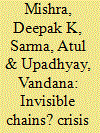

|
|
|
|
|
| Publication |
2011.
|
| Summary/Abstract |
During the post-liberalization period the Indian tea industry has been facing a severe crisis. This study looks at the question of inter-generational occupational mobility among tea garden labour in Assam, against the backdrop of, on the one hand, a fall in tea auction prices, decline in exports, and closure and abandonment of tea gardens; and on the other hand, increasing labour unrest, at times leading to violent protests and confrontations, declining living standards and worsening human security in the tea gardens. On the basis of data collected through first-hand primary research in three tea gardens of upper Assam, the paper analyses limitations on the inter-generational occupational mobility of tea garden labourers. We also probe into the reasons behind the relative mobility or immobility of tea garden labourers within and outside the tea gardens.
|
|
|
|
|
|
|
|
|
|
|
|
|
|
|
|
| 4 |
ID:
104008
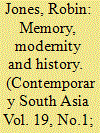

|
|
|
|
|
| Publication |
2011.
|
| Summary/Abstract |
This paper discusses the landscape garden of Lunuganga, Sri Lanka, designed by the architect Geoffrey Bawa for himself after 1948. It assesses this space as a site of memory and a location where modernity and history are negotiated. The present paper theorizes the making of Lunuganga in relation to the production of modernity in Sri Lanka and negotiation of the island's relationship to colonial and pre-colonial histories. The island of Sri Lanka has a long history of the development of cultural landscapes. Bawa's landscapes can be located within these traditions. Furthermore, the time he spent in Europe furnished him with an understanding of the picturesque landscape tradition. Lunuganga could be described as a site where these (colonial) histories and vernacular traditions re-staged or re-presented the modern in contemporary Sri Lanka. Bawa's landscapes can also be 'read' as 'sites of memory', where, although of the modern era, the past is recalled. The landscape of Lunuganga references negotiations between adoption of a universal modern, with its taint of colonial subjugation, the neglect of this troubled past and the pursuit of an uncomplex indigenism and, in so doing, intervenes in the production of modernity in Sri Lanka.
|
|
|
|
|
|
|
|
|
|
|
|
|
|
|
|
| 5 |
ID:
104011
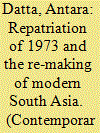

|
|
|
|
|
| Publication |
2011.
|
| Summary/Abstract |
In the aftermath of the 1971 war, nearly 250,000 people found themselves stranded in various parts of the subcontinent. These 'trapped minorities' became hostages in a complex negotiation process that highlighted how questions of citizenship and belonging remained unresolved in post-Partition South Asia. By studying three groups - the non-Bengalis, the Bengalis and the prisoners of war in a comparative perspective, this paper re-visits the question of who was welcome within certain borders and on what terms. It argues that these decisions depended not just on the state's policies towards 'outsiders' but also upon its own relationship with its minority communities.
|
|
|
|
|
|
|
|
|
|
|
|
|
|
|
|
| 6 |
ID:
104009


|
|
|
|
|
| Publication |
2011.
|
| Summary/Abstract |
This paper strives to pluralize notions of taste in relation to the canonized category of the Hindu or Indian temple. I put 'Hindu' in italics because I include Jain temples in my discussion and I put 'Indian' in italics because the architecture I discuss predates India as a nation-state and in the twenty-first century includes buildings in South and Southeast Asia as well as the Diaspora. Through a discussion of the Archaeological Preservation Aesthetic (APA) and multiple variants of the Ritual Renovation Aesthetics (RRA), new ways of looking emerge. This paper seeks to reconcile the hegemonic assumptions about art historical taste and the temple within an increasingly global environment. The main argument is predicated on temple users' practice as a form of curatorial practice in the field and provides a deep description of the multiplication of aesthetics due to increasing privatization of temple administration in India. The tenth-century cluster of temples from the Medapata region (Southern Rajasthan) serves as case study for a widespread phenomenon of putting ancient temples 'back' into worship during the second half of the twentieth and the beginning of the twenty-first century.
|
|
|
|
|
|
|
|
|
|
|
|
|
|
|
|
|
|
|
|
|